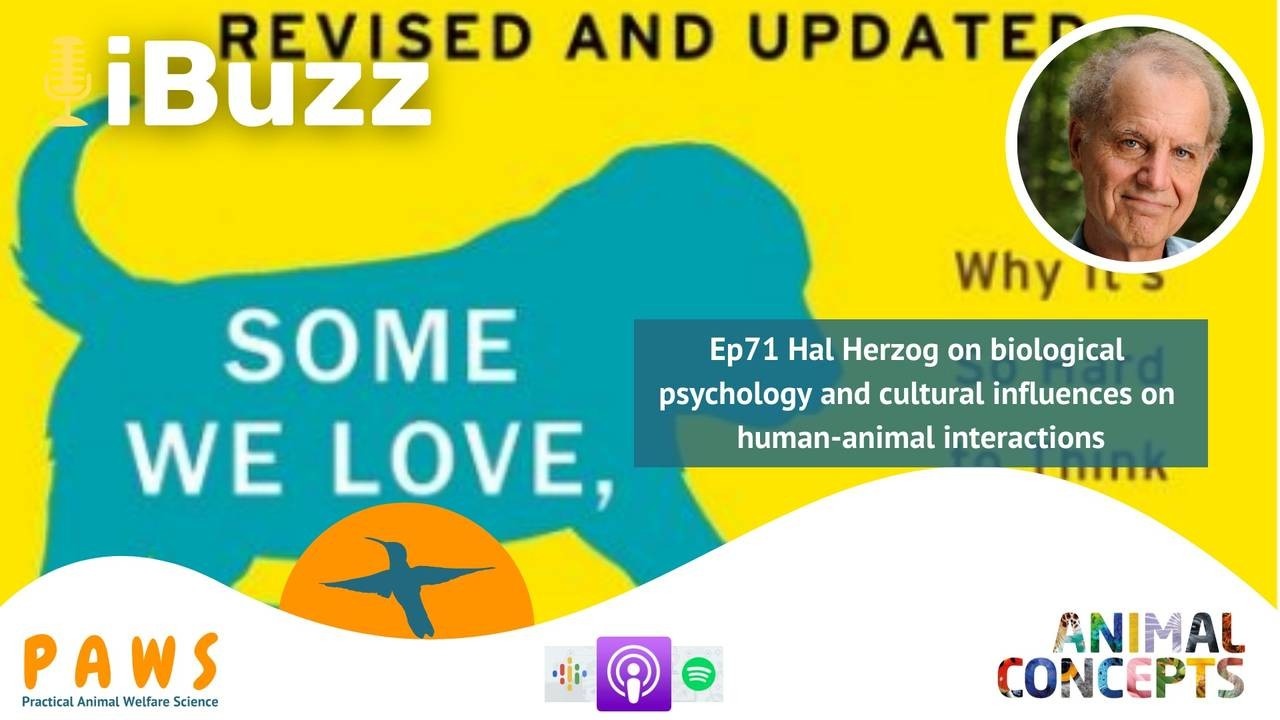Ep71 Hal Herzog on biological psychology and cultural influences on human-animal interactions

Hal Herzog is a professor of psychology at Western Carolina University, whose research entails the complex psychology of human-animal interactions for over three decades. These studies have been published in many journals, including Science, Animal Behavior and The American Psychologist to name a few. He also is the author of ‘Some We Love, Some We Hate, Some We Eat’ and writes the blog Animals and Us on Psychology Today.
Hal shares with us his love of animals from childhood, specifically reptiles. He quotes collecting reptiles during high school such as the boa constrictor, rat snakes, turtles etc. Hal then goes on to reference how his interest in human-animal interactions formed through his neighbours. They invited Hal to view a cockfighting match, which Hal initially refused. Eventually, Hal agreed due to his rising interest in how viewers perceive the roosters. This interest changed his PhD from snake personality differences to analysing the psychology of humans involved in cockfighting. Following the completion of his PhD, Hal flew to Vancouver, Canada to attend an international theology conference. Whilst at the airport Hal read ‘Animal Liberation’ by Peter Singer. Hal describes initially dismissing Peter’s perception of animal rights but continued to read due to Peter’s arguments being good. Originally, Hal perceived that Peter did not incorporate psychology, believing that logical arguments would not affect humans' treatment of animals. Now, Hal admits the whole book was effective at pulling the heartstrings. Hal then discussed his initial PhD study, working at Gordon Burghardt’s laboratory at the University of Tennessee. The aim was to develop a personality test for baby snakes. This test involved waving his hand in front of the snake to count how many times the snake struck within two minutes. The study demonstrated that siblings from the same litter behaved similarly, with recently fed snakes acting more aggressively as being fully limited their capacity to escape.
Hal defines biological psychology as how biology and evolution impact human behaviour. Hal highlights this term brings about questions regarding what it means to be human. He then goes on to discuss the controversial topic of human attachment to their pets. On one side, biophilia, whereby humans have an innate trait to love all animals. Hal disagrees with this but instead believes animal attachment relates to cultural learning. He noted that the term pet is westernised, referencing a study by Peter Gray which examines 60 human cultures. This study concluded that only five cultures played with their pets. The other cultures used them for work. Hal then explained that in nature, pet-keeping is limited, referencing one occasion where a chimpanzee plays with a bush baby, usually resulting in killing it. Consequently, Hal describes pet-keeping as the thing that separates us from other species.
Hal then discusses the impact of pets on human health. Historically, Erica Friedman in the 1980s concluded that pets increase their owner survival rate following a heart attack by four times more than those who do not own a pet. However, as Hal wrote his book, he discovered that there was an equal amount of papers stating that pets have a negative impact, no impact and a positive impact on the physical and mental health of their owners. This means no solid conclusion can be derived.
In addition, Hal noted that research shows gender differences concerning human-animal interactions are limited. With the data he had, Hal developed an animal attitude scale. He highlighted on extreme ends in America, that females are more likely to be animal activists (people who alter their life to help animals e.g., diet, wardrobe etc.), whereas, males are more likely to be hunters. Hal then discusses the cultural impact of animal care, giving the veterinary profession as an example. Stating how 30 years ago, this career was considered a male role, with current roles now being 60% women. Hal then discusses behavioural alterations of animal activists in regards to animal care and their philosophical orientation.
Hal then reviews how the animal welfare act is incorporated differently globally in terms of animal-based research. Hal considers history important, so shares with us the German Nazi parties progressive animal rights, restricting their use in research. On the other hand, the United States animal care and use committee covers all animals except rats, mice and birds. This means that the majority of animals used in research are not protected.
Hal then elaborates on the animal popularity trends, giving dog breeds as an example. Utilising the 60 million dogs registered with the American Kennel Club from 1926, it was determined that cultural fashion trends greatly affects dog breed popularity as people unconsciously follow trends. Hal referenced the Dalmatians popularity boom following Disney’s 101 Dalmations as an example.
Hal progresses to discuss why some animals humans seem to care more about compared to others, referring frequently to a paper by Burghardt and Herzog Jr; Beyond Conspecifics: Is Brer Rabbit Our Brother? Here he observes how "cuteness" is a key factor in species with conservation programmes, although he noted this changes with cultural perceptions. For example, how the killer whale changed to an orca.
Hal and Sabrina then discuss the recently published 2nd edition of his book; Some we love, some we hate, and some we eat. He wrote the book to be easily understood for the everyday person that aimed to get the public to question what they knew about animals. Hal was surprised by the book's popularity and incorporation into a lot of education courses.
Hal concludes by sharing with us his free blog on Psychology Today that consists of over 150 blogs.
Listen on your favourite player or directly HERE
Explore Hal Herzog’s research gate HERE
Listen to iBuzz podcast with Gordon Burghardt HERE
Read the Beyond Conspecifics: Is Brer Rabbit Our Brother? paper HERE
Read the Fashion vs. Function paper HERE
Read the Animals and Us Psychology Today blogs HERE
Become a member of PAWS HERE

